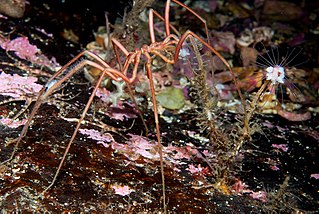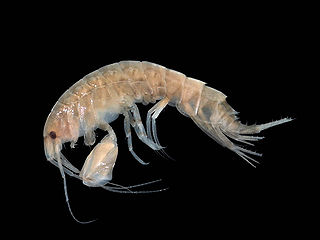
Mysidae is the largest family of crustaceans in the order Mysida, with over 1000 species in around 170 genera.
William Thomas Calman was a Scottish zoologist, specialising in the Crustacea. From 1927 to 1936 he was Keeper of Zoology at the British Museum.

Cumacea is an order of small marine crustaceans of the superorder Peracarida, occasionally called hooded shrimp or comma shrimp. Their unique appearance and uniform body plan makes them easy to distinguish from other crustaceans. They live in soft-bottoms such as mud and sand, mostly in the marine environment. There are more than 1,500 species of cumaceans formally described. The species diversity of Cumacea increases with depth.

Diastylis is a genus of crustaceans which belong to the family Diastylidae. It includes the following species:

Carditidae is a family of marine bivalve clams of the order Carditida, which was long included in the Venerida. They are the type taxon of the superfamily Carditoidea.

Bodotriidae is a family of crustaceans belonging to the order Cumacea. Bodotriids have a worldwide distribution in shallow and deep waters. There are over 380 described species in over 30 genera, being the most diverse cumacean family. Their external morphology differs from other cumaceans by a combination of traits that independently are not unique to the family: the telson is fused to the last abdominal segment, the dorsal part of the mandible has a boat shape (naviculoid), exopods exist on the third maxilliped and the first peraeopod, and there is a uropodal endopod with one or two articles.

Leuconidae is a family of marine hooded shrimp. The family was established by Georg Ossian Sars in his 1878 study of Mediterranean cumaceans.

Nannastacidae is a family of crustaceans belonging to the order Cumacea. They have no free telson. The endopods of the uropods are present on one segment. There are exopods on the maxillipeds and generally one on pereopods 1–4 in males and 1–2 in females. In the females the second antenna is much shorter than the first. It contains the following genera:

Bodotria is a genus of crustaceans which belong to the family Bodotriidae. It includes the following species:

Iphinoe is a genus of crustaceans which belong to the family Bodotriidae. It includes the following species:
Nannastacus is a genus of crustaceans in the order Cumacea. It contains the following species:
Cyclaspis is a genus of cumacean crustaceans in the subfamily Bodotriinae, containing the following species:

Nymphon is a genus of sea spiders in the family Nymphonidae. The species of sea spiders within the genus Nymphon are all benthic organisms and are found in abyssal and bathyal areas of the ocean. This is a fully marine group and can be found at various depths ranging from the littoral zones to the deep sea. They are found in most major oceans across the globe with a strong distribution around polar regions: Arctic and Antarctic waters. Out of the sea spider genus, Nymphon is the most rich, with a majority of the species within the genis being found in the Southern Ocean region. This genus may also contain bioluminescent species.

Campylaspis is a genus of crustaceans in the order Cumacea. Species of Campylaspis have a "bulky" carapace, which makes up more than 40% of the animal's length, as well as distinctive features of the mouthparts. There are currently 170 recognised described species:

Abludomelita is a genus of amphipod crustacean.
Mysidopsis is a genus of mysid shrimps in the family Mysidae. The sensitivity of these shrimps to water quality makes them suitable for bioassays. Mysidopsis bahia and Mysidopsis almyra, which are used frequently to test for pesticides and other toxic substances, are now classified as Americamysis bahia and Americamysis almyra.

The clade Multicrustacea constitutes the largest superclass of crustaceans, containing approximately four-fifths of all described crustacean species, including crabs, lobsters, crayfish, shrimp, krill, prawns, woodlice, barnacles, copepods, amphipods, mantis shrimp and others. The largest branch of multicrustacea is the class Malacostraca.
Dimorphostylis is a genus of crustacean from the Diastylidae family. The scientific name of this species was first published in 1921 by Zimmer.










